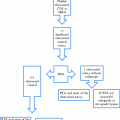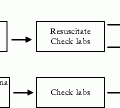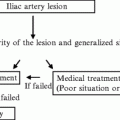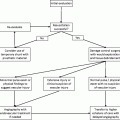Fig. 15.1
Classification system of the proximal landing zone of TEVAR
(a)
Zone 0: The proximal edge of the graft is proximal to the innominate artery. All 3 branches of the arch are covered.
(b)
Zone 1: The graft is proximal to the left common carotid artery. The left common carotid and the left subclavian arteries are covered.
(c)
Zone 2: The graft is proximal to the left subclavian artery. Only the left subclavian artery is covered.
(d)
Zone 3: The graft is located less than 2 cm distal to the left subclavian. All three aortic arch branches are kept patent.
(e)
Zone 4: The graft is located more than 2 cm distal to the left subclavian artery.
5 Diagnosis: Clinical
Most thoracic aneurysms are discovered incidentally on imaging studies as they are rarely detectable by physical exam. Patients can present with chest pain, back pain, or flank pain. Uncommonly, the aneurysm can compress adjacent structures and cause hoarseness (recurrent laryngeal nerve), dysphagia (esophagus), dyspnea (bronchus), or superior vena cava syndrome. Rarely, distal embolization from thrombus in the aneurysm sac can cause mesenteric or lower extremity ischemia. Rupture typically causes severe chest pain and shock.
6 Diagnosis: Imaging
CT angiography provides virtually all the required information for diagnosis and operative planning and has become the test of choice for imaging all thoracic aortic pathology. Multi-row detector CT scans with thin-slice axial reconstructions (0.6–2.5 mm) can be obtained with a single breath hold and give accurate measurements of the aneurysm size and its relation to major aortic branches. Three dimensional and multiplanar reconstructions can improve the evaluation of the aneurysm especially with tortuous and angulated anatomy and provide excellent assessment of the proximal and distal landing zones for endografting. MRA is an alternative to CTA in specialized centers. It is inferior to CTA in assessing aortic wall characteristics and calcifications.
7 Management
Since most aneurysms are asymptomatic and discovered incidentally, management decisions are based on their natural history. No prospective studies are available and the risk of rupture is estimated based on size from observational retrospective series. A 1–3 % yearly risk is estimated for an aneurysm 50–60 mm in diameter. It increases to 5–7 % when the size of the aneurysm is larger than 60 mm. The decision to intervene should be individualized taking into consideration the patient’s age, comorbidities, and life expectancy. Traditionally, using open repair, the risk benefit ratio in an average patient would suggest a procedure when the aneurysm reaches 60 mm. Patients with Marfan syndrome are treated earlier when the aneurysm reaches 50 mm in size. A rapid growth more than 10 mm per year is another indication for surgery. Saccular aneurysms are presumed to have a higher rupture risk and are treated at a smaller size. Aneurysms that cause symptoms should be treated regardless of size.
8 Open Surgery
Open repair of descending thoracic aneurysm is performed through a left thoracotomy or a left thoracoabdominal incision depending on the extent of the aneurysm, using single lung ventilation. Exposure may require the resection of a rib with extensive disease. Proximal control is obtained distal to the left subclavian artery or between the left subclavian and the left common carotid artery. The aneurysm is replaced with a dacron graft using monofilament sutures. Several techniques are employed to decrease major complications such as ischemia to the viscera and the spinal cord:
(a)
A lumbar drain draws CSF out of the spinal canal and can be used to maintain a low intrathecal pressure around 10 mm Hg. This increases the perfusion pressure to the spinal cord and has been shown to reduce the incidence of spinal cord ischemia and paraplegia. Elevating the systemic blood pressure also helps improve spinal cord perfusion. The lumbar drain is usually removed on postoperative day 3 providing some additional protection in the postoperative period in cases of delayed onset of paraplegia.
(b)
Left heart bypass using biomedicus pump drives the blood from the left pulmonary vein/left atrium to the left femoral artery. It provides both retrograde perfusion to the visceral organs and “unloads” the pressure from the heart contracting against a cross-clamped aorta.
(c)
Reimplantation of the lower thoracic intercostal arteries preserves blood supply to the spinal cord.
9 Intervention: Techniques and Pitfalls
Thoracic endovascular aneurysm repair (TEVAR) can be performed under general, regional, or local anesthesia. There are three endografts currently available commercially in the US for the treatment of descending thoracic aneurysms: Gore TAG, Medtronic Talent, and Cook TX2. There are inherent differences between these devices that are important to understand and are illustrated in Table 15.1.
Table 15.1
Characteristics of the thoracic endografts
TAG | Talent | TX2 | |
|---|---|---|---|
Composition | ePTFE with sutureless nitinol stents | Dacron polyester sewn to nitinol stents | Dacron polyester sewn to stainless steel stents |
End configuration | Covered flares with sealing cuff at the base | Bare Spring | Covered stent with barbs proximally, bare stent with reversed barbs distally |
Measurements | Inner diameter (ID) | Outer diameter (OD) | Outer diameter (OD) |
Neck—Length | ≥20 mm | ≥ 20 mm | ≥25 mm |
Neck—Diameter | 23–37 mm (ID) | 18–42 mm (OD) | 24–38 mm (OD) |
Graft size (mm) | 26, 28, 31, 34, 37, 40 | 22–46 in 2 mm increments | 28–42 with 2 components |
Graft length (mm) | 100, 150, 200 | 112–116 | 108–216 |
Introducer sheath size | 20–24 F, Length = 30 cm, flexible | No sheath—Catheter size 22–25 F (OD) | Graft loaded into a 20–22 F (OD) Flexor introducer sheath |
Delivery system | Device constrained by a sleeve on delivery catheter | Xcelerant | H&L-B One-shot introduction system |
Deployment | Rapid from center to both ends | Controlled—Proximal to distal | Controlled—proximal to distal |
Companion balloon | GORE Tri-lobe balloon | Reliant balloon | CODA balloon |
9.1 General Guidelines
1.
The recommended landing zone length of various endografts is intended for regions with good circumferential apposition. The required length is increased around angulated areas such as the dome of the arch.
2.
Measurements and oversizing are different for different grafts.








